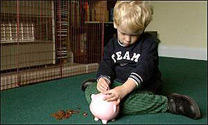 |
 |
![]() Do you give
your children pocket money?
Do you give
your children pocket money?
![]() If so, how
much do you give them and what do they spend it on?
If so, how
much do you give them and what do they spend it on?
![]() Do they
receive it every month, every week or every two weeks?
Do they
receive it every month, every week or every two weeks?
![]() Read the following article and choose the most suitable word for each space.
Follow the example.
Read the following article and choose the most suitable word for each space.
Follow the example.
Many children
can learn the of money by receiving a weekly or monthly amount of pocket
money. Parents often give their children an amount of money that they may
spend as they wish. This gives the children a of independence and lets them learn from experience at an age
when financial mistakes are not very costly. A child may receive their pocket money each week or each month. The amount is not so important, but parents should make clear what, if anything, the child is expected to with the money. At first, young children may spend all of their pocket money soon after they receive it. If they do this, they’ll learn the hard way that spending must be done within . Parents should not give more money until the next of money is to be paid. Older children may be responsible enough to larger costs like those for clothing. The object is to show young people that managing money demands choices between spending and saving. The amount you give may become more complicated as your child gets older and starts asking his or her friends how much they receive. The friends may to get much more than your child does. If possible, have a quiet chat with other parents to establish the going , and then decide what you think is reasonable. Many people say it is not a good idea to pay your child for work around the home. These jobs are a normal part of family life. Paying children to do extra chores, however, can be . It can even provide an understanding of how a business . As your children get older, they may want more expensive extras, such as sports shoes, a computer game or an Mp3 player. You could suggest you'll pay some of the money if they contribute three or four weeks' pocket money the cost.  Pocket
money gives children a chance to experience three important things they
can do with money. They can it in the form of gifts or giving to charitable organizations.
They can spend it by buying things they want. Or they can save it. Saving
helps children understand that costly require sacrifice, and that you have to
costs and plan for the future. Pocket
money gives children a chance to experience three important things they
can do with money. They can it in the form of gifts or giving to charitable organizations.
They can spend it by buying things they want. Or they can save it. Saving
helps children understand that costly require sacrifice, and that you have to
costs and plan for the future. Encouraging children to save part of their money can also to future saving and investing. Many banks offer free savings accounts for young people with small amounts of money. A bank account is an excellent way to show children the power of compound interest. Compounding works by paying interest on interest. For example, one euro at two percent interest for two years will earn two cents in the first year. In the second year, the money will earn two percent of one euro and two cents. That may not seem like a lot. But an investment that earns eight percent compounded yearly will increase one hundred percent in value in about nine years. |
|
|
pocket money = asignación (US = allowance) chores = tareas domésticas compound interest = interés compuesto gifts = regalos |
![]() Read the text
again and choose the correct answer.
Read the text
again and choose the correct answer.
| 1. Which of the following is
NOT quoted in the article as an advantage for giving pocket money. a) It teaches young children to be independent. b) If they make a mistake with money at a young age, they won’t lose too much. c) They can buy presents for their parents. d) Children can learn how bank accounts work.  2. The article suggests that parents should a) only give more spending money at the correct time (every week, month, two weeks etc.). b) let their children decide how much their allowance should be. c) give their children more money as soon as they spend their allowance. 3. The amount of pocket money you give your children should be a) whatever they ask for. b) increased if they want to buy something special, such as clothing. c) less than their friends receive so that your children’s friends don’t get envious. d) similar to what your children’s friends receive if you think this amount is realistic. 4. The article suggests that children open a bank account to  a) help them give money to charity. b) learn how to earn more money by saving it. c) stop them spending their money on clothes and Mp3 players. d) make them grow up quicker. 5. If you invest one euro at 8% compound interest for nine years, you will have a) about one hundred euros. b) one euro and two cents. c) about two euros. d) about one euro and two cents every year for nine years. |
![]() Before
you read a report about the pocket money children receive in Britain, chose an
answer to the following questions.
Before
you read a report about the pocket money children receive in Britain, chose an
answer to the following questions.
| 1. Who get more pocket
money, English, Scottish, Irish or Welsh children? a) English children  b) Scottish children c) Irish children d) Welsh children 2. In the 12-16 age group, who receive more money, boys or girls? a) boys b) girls 3. What percentage of children in the UK have to work around the house to earn their pocket money? a) 15% b) 35% c) 55% d) 75% 4. According to the survey, how many British children shop online? a) less than 30% b) between 30% and 50%  c) more than 50% 5. What is the most popular product for an average British child? a) a computer game b) a music CD c) a DVD or video d) a mobile phone |
![]() Now read the
report and check your answers.
Now read the
report and check your answers.
The amount of pocket money paid to the nation's children went up seven per
cent last year, according to the British bank Halifax.  Halifax found that parents are now giving their children on average £8.37 a week, with boys being paid about 50 pence more than girls. This rise in the money children receive was four times the rate of inflation, the measure of how much the price of goods in shops rises in a year. "It appears that children are certainly getting a good deal when it comes to pocket money levels, which have increased well above the rate of inflation over the last year," said Cheryl Millington, head of savings at Halifax. Welsh children received the most at £13.51 a week, with those in the South West of the UK being given just £4.87. Children in the capital saw their weekly money go up 41 per cent to £10.22 in 2004. Unsurprisingly, Halifax found that older children receive more money, but while boys receive more money in general, girls in the 12-16 age group get more money than boys of the same age. But things are not as easy as they seem for the nation's youth as more and more children have to work for their money. "Many more children now have to do chores to earn their pocket money, as parents try to teach them the value of money. We are also beginning to see a generation of young consumers who are starting to take control of their own earning potential, spending and savings habits," Ms Millington noted. While last year fewer than one child in seven had to work for their money, now a massive 55 per cent are made to do jobs around the home to receive their allowance.  Halifax,
which has been running its pocket money survey since 1987, also looked at
how children are spending their money. It found that money is going to a
mix of traditional and 21st Century sources. While four out of five
children are spending money on sweets, chocolate, and crisps; more than
two in three now own a mobile phone. Almost half of these pay their own
bills, with 80 per cent of children's mobile phones set up on a
pay-as-you-go basis. More than half children shop online, with CDs the
most popular purchase followed by computer games and DVDs/videos. Almost
three quarters of children also spend cash on going out and eating out Halifax,
which has been running its pocket money survey since 1987, also looked at
how children are spending their money. It found that money is going to a
mix of traditional and 21st Century sources. While four out of five
children are spending money on sweets, chocolate, and crisps; more than
two in three now own a mobile phone. Almost half of these pay their own
bills, with 80 per cent of children's mobile phones set up on a
pay-as-you-go basis. More than half children shop online, with CDs the
most popular purchase followed by computer games and DVDs/videos. Almost
three quarters of children also spend cash on going out and eating out
|
![]() You are going
to listen to a report which is similar to the one you have just read. However,
there are 10 differences in the audio. Write the differences below
without looking at the original text.
You are going
to listen to a report which is similar to the one you have just read. However,
there are 10 differences in the audio. Write the differences below
without looking at the original text.
Read the text one more time before you listen and use the pause button on your media player to give you time to make notes.
La Mansión del Inglés. https://www.mansioningles.com
© Copyright La Mansión del Inglés C.B. Todos los derechos reservados.


